
Monday, December 11, 2017
Three UC San Diego Computer Scientists Elected ACM Fellows in Class of 2017
Three computer scientists from the Jacobs School of Engineering at the University of California San Diego have been elected Fellows of the Association for Computing Machinery (ACM). ACM is the world’s largest educational and scientific computing society.
In announcing its Class of 2017 Fellows, ACM cited:
- Computer Science and Engineering (CSE) professor Ravi Ramamoorthi for his “contributions to computer graphics rendering and physics-based computer vision”;
- CSE professor Alexander Vardy, whose main faculty appointment is in Electrical and Computer Engineering (ECE), was cited for his “contributions to the theory and practice of error-correcting codes and their study in complexity theory”; and
- CSE professor Geoffrey M. Voelker was honored for “contributions to empirical measurement and analysis in systems, networking and security.”

Ravi Ramamoorthi, Alexander Vardy and
Geoffrey M. Voelker
“Professors Ramamoorthi, Vardy and Voelker have all been pioneers in their respective fields of graphics and vision, computer systems and networking, and information and coding theory,” said CSE chair Dean Tullsen. “They all richly deserve the honor of being elected by their peers to be Fellows of the ACM.”
The addition of Ramamoorthi, Vardy, and Voelker brings to 11 the number of ACM Fellows among active faculty in the CSE department. Prior honorees included Victor Vianu (2006), Pavel Pevzner (2010), Stefan Savage (2010), Dean Tullsen (2011), Andrew Kahng (2012), Yuanyuan Zhou (2013), Mihir Bellare (2013), and Rajesh Gupta (2016). Ramamoorthi – who became an IEEE Fellow at the beginning of the year – and Vardy – who became an IEEE Fellow in 1999 – are now two of only six CSE faculty to be Fellows of both ACM and IEEE. The others are professors Kahng, Tullsen, Zhou and Gupta.
Elected ACM Fellows represent the top 1% of ACM members for outstanding accomplishments in computing and information technology. The induction of new ACM Fellows will take place on Saturday, June 23, 2018 in San Francisco at the annual ACM Awards Banquet.
For more details on the new ACM Fellows' research and contributions, see following articles.
New ACM Fellow: CSE Professor Ravi Ramamoorthi
With 64 papers in ACM SIGGRAPH and the ACM Transactions on Graphics, Ramamoorthi is widely acknowledged as the leading researcher in rendering (one of the four main areas of computer graphics). He has published more than 140 papers to date in computer graphics and computer vision.
As early as 2007, Ramamoorthi received the ACM SIGGRAPH Significant New Researcher Award for his “groundbreaking work on the mathematical representations and computational models for the visual appearance of objects." One year later, at the White House, he was awarded a Presidential Early Career Award for Scientists and Engineers (PECASE) for his work in physics-based computer vision.
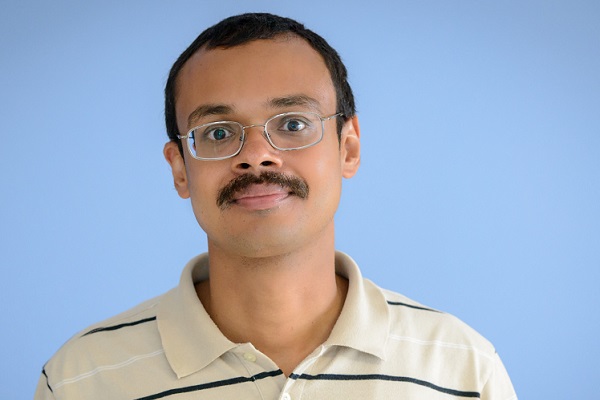
Among other honors, Ramamoorthi has received an NSF CAREER Award and Sloan Fellowship (both in 2005), an Office of Naval Research Young Investigator Award in 2007, an Okawa Foundation Research Grant in 2011, five recent Google Research Awards, and was named an ACM Distinguished Scientist in 2015.
Ramamoorthi joined the Computer Science and Engineering (CSE) department at UC San Diego in July 2014, where he is the inaugural holder of the Ronald L. Graham Endowed Chair of Computer Science. He is also founding director of the Center for Visual Computing (VisComp) in UC San Diego’s Jacobs School of Engineering.
The computer scientist notes that he is particularly proud of his role in teaching and mentoring the next generation of graphics and vision researchers. “In the course of my career, I have advised and graduated more than 20 postdoctoral scholars and Ph.D. students,” explained Ramamoorthi. “When I came to UC San Diego, I set out to develop a leading research group here, and I am proud to say we are succeeding, just as we did previously at UC Berkeley, and before that at Columbia University.”
Ramamoorthi first introduced a revolutionary signal-processing framework for light reflection in his Ph.D. thesis and a series of papers at SIGGRAPH and the Journal of the Optical Society of America (JOSA) in 2001 (which have been cited more than 1,500 times to date). He expressed reflection for a curved surface as convolution, with incident illumination playing the role of the signal, and the reflectance function of the surface playing the role of the filter. “To do so, we had to address problems that were open for more than two decades in computer graphics and vision,” recalled Ramamoorthi. “This solution became standard for complex lighting in computer vision for applications ranging from lighting-insensitive face recognition to 3D reconstruction.”
The computer scientist’s approach to spherical-harmonic lighting is now standard in video games (such as Halo) as well as movies (including Avatar), and since mid-2011, the technique is part of the industry-standard Renderman software. Ramamoorthi was also a consultant to Pixar when the company changed its rendering pipeline to include importance-sampling with physically-based shading in 2011.
Ramamoorthi’s papers on structured importance sampling (developed collaboratively with fellow UC San Diego professor Henrik Wann Jensen) for complex lighting and later reflectance functions at SIGGRAPH 2003 and 2004 established the first methods for efficiently rendering with environment lighting and measured reflectance. In a sequence of papers from 2009 to the present, Ramamoorthi also developed the theoretical foundations and practical methods for sparse sampling and reconstruction in Monte Carlo image synthesis, which have produced the most dramatic recent sample count reductions, and revolutionized industrial practice. A 2015 Eurographics State-of-the-Art Report identified Ramamoorthi’s SIGGRAPH and SIGGRAPH Asia 2009 papers as seminal.
Ramamoorthi has also made key contributions to data-driven methods. His SIGGRAPH 2006 paper on inverse shade trees is widely reproduced to acquire, represent and 3D-print spatially-varying reflectance. He also pioneered signal-processing methods to acquire complex light transport, developing the first compressive sensing methods in vision/graphics. His works on 3D scanning, including spacetime stereo and combining positions and normals are believed to have been the inspiration for methods in modern depth-sensors such as Kinect or Real-Sense. Ramamoorthi, along with former postdoc and now fellow CSE professor Manmohan Chandraker, has also derived new photometric invariants based on differential measures for shape recovery with general reflectance. These have the potential to revolutionize textbook approaches to 3D recovery in physics-based computer vision.
Ramamoorthi’s most recent work on simulating light "glints" off fine-surface detail (in a paper at SIGGRAPH 2016) has generated wide press coverage.
Also to his credit, Ramamoorthi pioneered the first massive open online course (MOOC) in computer graphics while at UC Berkeley. The online course was one of the first nine offered on the edX platform. Now part of UC San Diego’s presence on edX as the first UC San DiegoX course, Ramamoorthi’s CSE167x has reached over 100,000 registrations, while his lectures posted on YouTube have attracted more than half a million views. The course has also been translated into Mandarin and licensed for Chinese students. Ramamoorthi was one of 10 finalists worldwide across all subject areas for the inaugural edX Prize for Exceptional Contributions in Online Teaching and Learning, first in 2016 and again in 2017. Ramamoorthi was the only computer science professor to be so honored, and the only two-time finalist.
New ACM Fellow: CSE/ECE Professor Alexander Vardy
Since 2013 Professor Vardy has held the Jack Keil Wolf Endowed Chair in Electrical Engineering in the Jacobs School of Engineering, where he has joint appointments in the ECE and CSE departments. He joined the school in 1998 from the faculty of the University of Illinois at Urbana-Champaign. Prior to Illinois, Vardy worked in the private sector, including two years at the IBM Almaden Research Center, after completing his Ph.D. in Electrical Engineering in 1991 at Tel Aviv University.
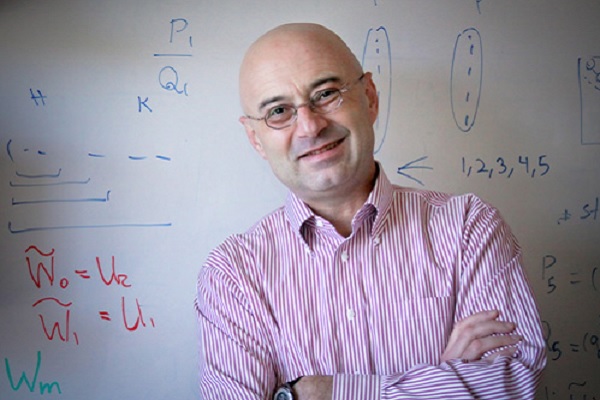
Alexander Vardy has faculty appointments in both ECE
and CSE departments.
Vardy is a leading expert in coding theory, information theory and communications. Over a span of three decades, Professor Vardy has contributed consistently and profoundly to the theory and practice of error-correcting codes and to their study in complexity theory. With the recent adoption of polar codes in the 5G wireless standard, his work has also had a tremendous impact in practice. When polar codes were discovered in 2009, they were regarded as being of purely theoretical interest, since major obstacles prevented their utilization in practice. However, seven years later, 3GPP voted to adopt polar codes in the 5G standard, largely because of Vardy's groundbreaking work in polar coding, and in particular, his ingenious list-decoding algorithm for polar codes. Among several dozen contributions to the 5G standard that study polar codes, every single one references his list-decoding algorithm and award-winning paper. In 2017, Vardy and co-author Ido Tal received the Communications & Information Theory Societies Joint Paper Award for their landmark 2015 paper on "List Decoding of Polar Codes".
Other examples of Vardy's impact on coding theory have included his award-winning paper (with his postdoctoral fellow Ralf Koetter) on algebraic soft-decoding of Reed-Solomon codes. The paper has had great resonance, with leading academic and industry researchers further developing the Koetter-Vardy algorithm, including implementations in software and hardware. Vardy’s paper won the IEEE Information Theory Society Paper Award and resulted in a key patent, and the Koetter-Vardy algorithm is now used in radio communications (JT65 Protocol) and other applications. Vardy also invented a radically new type of code with his student Farzad Parvaresh. Their breakthrough work won the Best Paper Award at the 2005 Symposium on Foundations of Computer Science (FOCS), and today, Parvaresh-Vardy codes are used to construct the best-known unbalanced expanders, randomness extractors, and explicit coding schemes achieving list-decoding capacity.
Vardy's research and its influence transcend coding theory. He was highly influential in establishing a bridge between the information theory and cryptography communities, after publishing a paper extending the cryptographic notion of semantic security to wiretap channels – a model studied for decades in information theory. Vardy also contributed profoundly to the study of lattices. These contributions include his algorithm for maximum likelihood decoding of the Leech lattice (still the best-known) and his discovery of an especially dense 20-dimensional sphere-packing, which disproved a 25-year-old conjecture about laminated lattices. Vardy's work outside of coding theory has also spanned a wide range from very practical problems (e.g., collisions in RFID tag-singulation protocols) to questions of purely mathematical interest (e.g., q-analogues of Steiner systems).
Among his many honors, Vardy is a past recipient of the David and Lucile Packard Fellowship and an NSF CAREER Award. He is also a past Editor-in-Chief of IEEE Transactions on Information Theory, Editor of the SIAM Journal on Discrete Mathematics, and Program Chair of the ISIT. Most importantly, his contributions – reported in over 200 journal/conference publications and 10 patents – had a lasting impact on the development of error-correcting codes and other fields of computer science.
New ACM Fellow: CSE Professor Geoffrey M. Voelker
Professor Geoffrey M. Voelker joined the CSE faculty at UC San Diego nearly 18 years ago, in January 2000. He did so after earning his Ph.D. in Computer Science and Engineering from the University of Washington the same year. Voelker completed his undergraduate degree at UC Berkeley in 1992, then moved to the University of Washington to get his M.S. (in 1995) and Ph.D.

Professor Voelker’s primary research interests include computer systems research in operating systems, distributed systems, networking, as well as mobile and wireless computing. Among his recent projects in networking and security, Voelker has worked in areas ranging from wireless networks to machine virtualization, cloud storage and cybercrime.
“My research is both experimental and empirical,” said Voelker. “As a result, a considerable amount of my work involves system and network measurement in addition to design, implementation and evaluation.” Exemplifying such work over his career, in 2017 Voelker accepted the Test of Time Award from the USENIX Security Conference, awarded for a landmark paper that won the conference’s Best Paper award 16 years earlier. The paper on “Inferring Internet Denial-of-Service Attacks” provided the only publicly available data quantifying DDoS activity on the Internet at the time. (Pictured: Voelker accepting the Test of Time Award from Stanford’s Dan Boneh at USENIX Security 2017.)
Voelker is a member of both the Systems and Networking research group in CSE, as well as the Security and Cryptography group. He is also affiliated with the Center for Networked Systems, Center for Wireless Communications, and Calit2’s Qualcomm Institute.
CSE Professor Elevated to IEEE Fellow in Class of 2018
CSE Professor Tajana Rosing has been elected a Fellow of the Institute of Electrical and Electronics Engineers (IEEE). She is one of five Jacobs School of Engineering faculty members elevated to be part of the IEEE Fellows class of 2018. (Others include ECE's Massimo Franceschetti and David Whelan, as well as MAE's Sonia Martinez and James Friend.)
IEEE honored Rosing for her "contributions to power and reliability management of Systems-on-Chip."
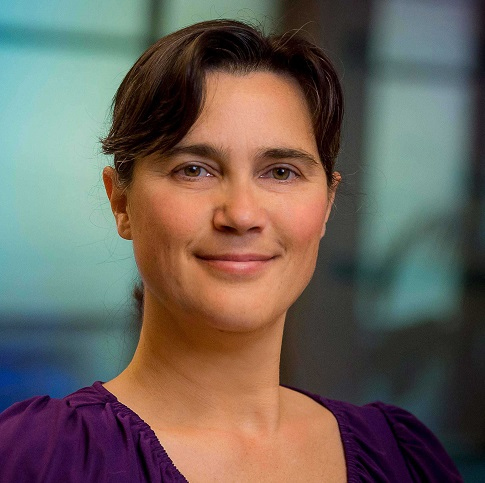
an IEEE Fellow.
In the past year, Rosing was named holder of the John J. and Susan M. Fratamico Endowed Chair in the Jacobs School of Engineering. She also became co-director of the Artificial Intelligence and Healthy Living Center (AIHL), a new joint center between UC San Diego and IBM Research. The groundbreaking center promotes critical research and applications in two thematic areas: Healthy Aging (led by Rosing) and the Human Microbiome (led by CSE and Pediatrics professor Rob Knight), together with co-directors from IBM Research.
Rosing leads the System Energy Efficiency Laboratory (SEELab) in CSE. The lab focuses on energy efficiency in all kinds of systems, from sensor nodes to smart cities. In addition to energy-efficient computing, her primary research interests include context-aware computing, human-cyber-physical system design, embedded systems hardware and software design, resource management at the system level, and the design of approximate and highly efficient architectures. In her current research, Rosing investigates efficient, distributed data collection, aggregation and processing of data in the context of smart cities, wireless healthcare, as well as Internet of Things applications.
"Professor Rosing's creativity and approach to research have had a deep impact on innovation in computer engineering," said CSE chair Dean Tullsen. "Her elevation to be an IEEE Fellow is well-deserved in light of her many contributions to the field of energy efficiency in computing systems."
Rosing's recent work builds on her use of information present in wireless systems to achieve more efficient system operation. She focuses on efficiently extracting knowledge about context from sensing observations of human behavior and needs as well as from stationary or mobile environmental sensing systems. Rosing has leveraged that knowledge to implement distributed control algorithms for large-scale Internet of Things applications underlying Smart Cities infrastructure. A recent example includes using drones to detect areas of higher air pollution collaboratively and dynamically, and to provide this feedback in real time in emergencies (e.g., forest fires), and in normal daily life (such as air pollution due to recent fertilization of nearby fields, or due to higher than normal and localized smog conditions).
The computer engineer has also leveraged context to optimize the operation and design of embedded systems by maximizing energy efficiency in exchange for controllable and tolerable inaccuracies in computation. According to Rosing, this research has resulted in systems that are up to 1,000 times more energy efficient with less than a 10 percent error in computation. "These systems are especially applicable to many Internet of Things applications where the data sources themselves are not completely accurate," said Rosing.
Among other real-world impacts coming out of her research, Rosing cites a longer battery life for smartphones. "My work involves optimizing the battery life, communication and storage of portable electronic devices, including cell phones, laptops and sensors," she said. "I also work on large systems... optimizing smart servers to maximize quality of service while minimizing power consumption. This research translates into significant energy savings."
Prior to joining the CSE faculty in 2005, Rosing was a full-time researcher at HP Labs, focusing on low-power wireless media and embedded systems. While at HP Labs in Palo Alto, she finished her M.S. and Ph.D. degrees at Stanford in 2000 and 2001, respectively. Rosing's doctoral dissertation topic was "Dynamic Management of Power Consumption." Prior to HP Labs and Stanford, she worked as a senior design engineer at Altera Corporation.
In addition to her primary faculty appointment in CSE, the computer-engineering professor is an adjunct professor in ECE and she is affiliated with the Contextual Robotics Institute, Qualcomm Institute and San Diego Supercomputer Center, as well as six other UC San Diego research centers focused on Networked Systems (CNS), Microbiome Innovation (CMI), Wearable Sensors (CWS), Energy Research (CER), Sustainable Power and Energy, and the newly-launched Center for Machine-Integrated Computing and Security (MICS).
Computer Scientist Fights Cancer, Now Wages War on Safety Threats to Women
CSE and Pediatrics assistant professor Debashis Sahoo develops computational models for human cancer and uses them to predict important biomarkers and therapeutic targets. But he is also raising hopes in a very different area.

The UC San Diego professor and his wife, Sonalisa Pandey, are the brains behind the team Shanvi -- named for their daughter -- which was chosen to be one of 21 semifinalists in a global competition to come up with inexpensive devices to help women respond to threats of many kinds.
The $1 million Anu and Naveen Jain Women's Safety XPRIZE is administered in India but the contest is open to ideas and inventors around the world. The competition challenges teams to "leverage technology to create accessible and affordable safety solutions that help tackle violence and harassment against women."
One in three women have faced physical or sexual violence in their lifetime, yet 90 percent of victims don't report it, according to philanthropist Anu Jain: "We sparked this initiative to curb the harassment epidemic against women and empower them to pursue their dreams."
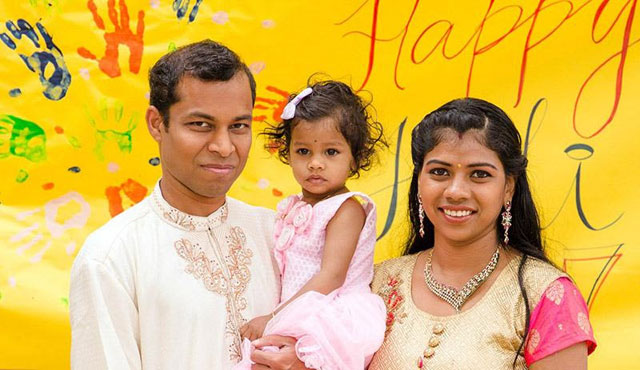
Shanvi, the namesake of their XPRIZE team in the
semifinals.
To keep the price of innovation down and ensure that winning ideas can be made available to women in developing countries, competitors must come up with a device or technology that can sell for $40 at the high end. Sahoo, Pandey and the 20 other teams in the semifinals now have six months to develop a prototype of their wireless devices. The minimum functionality must show that an emergency alert can be triggered, and critical information relayed to community responders within 90 seconds.
Sahoo's Shanvi team submitted a proposal to develop a "hardware and software solution for safety triggers and response using the latest technology." Specifically, they aim to build a wireless device that can be hidden in a woman's clothing. Rather than requiring the user to turn it on or to say specific words to alert emergency responders, the device would simply monitor the user's breathing, If her breathing is fast or erratic, the device would launch a smartphone app and send an alert automatically to responders.
As Sahoo told KPBS recently, "in a situation where the user's arms are physically restrained, you can actually send a signal through your breathing patterns, and nobody can block that."
All 21 prototypes will be tested next April in Mumbai, India. The Women's Safety XPRIZE will award $1 million to the Grand Prize-winning team in June 2018.
Newest Ph.D. Alumnus Graduates with Dissertation on Security and Cryptography
On Dec. 6, Ph.D. Candidate Michael Walter passed his final dissertation defense on the subject of, "On the Concrete Security of Lattice-Based Cryptography." His advisor, Daniele Micciancio, chaired the panel that included three other security and cryptography faculty in CSE -- professors Mihir Bellare, Shachar Lovett and Hovav Shacham -- as well as Kenneth Zeger from the Electrical and Computer Engineering department.

Lattice-based cryptography is a popular but relatively new subfield of cryptography, noted Walter, and "practical proposals for lattice-based cryptographic primitives have only recently started to emerge." In the abstract to his thesis, Walter asked, "How do we ensure that any practically conceivable adversary is unable to break the scheme? He went on to expore two critical issues in this context. First, said Walter, The common approach to analyzing a concrete cryptographic primitive is to analyze the performance of known algorithms to estimate the attack complexity of a hypothetical adversary. This requires a thorough theoretical understanding of the best-performing algorithms. Unfortunately, for many subclasses of lattice algorithms there is a gap in our understanding, which leads to problems in the cryptanalytic process. Walter addressed such issues in two closely-related subclasses of such algorithms, and developed new algorithms while analyzing existing ones and showing that in both cases, it was possible to obtain algorithms that are both theoretically well understood and competitive in practice."
Separately, Walter focused on an integral part of most lattice-based schemes: sampling from a specific distribution over the integers. Implementing such a sampler securely and efficiently can be challenging for distributions commonly used in lattice-based schemes. The researcher introduced new tools and security proofs that reduce the precision requirements for samplers, allowing more efficient implementations in a wide range of settings, while maintaining high levels of security.
Finally, Walter proposed a new sampling algorithm with a unique set of properties desirable for implementations of cryptographic primitives.
Prior to enrolling in the Ph.D. program in CSE, Walter completed his undergraduate and Master's degrees at Germany's Technische Universitat Darmstadt (in 2009 and 2012, respectively). Among his most recent publications, Walter co-authored two high-profile papers with professor Micciancio. Last July, they had a paper* at the 2017 International Cryptology Conference (CRYPTO 2017) on "Gaussian Sampling over the Integers: Efficient, Generic, Constant-Time". In 2016, Micciancio and Walter had a joint paper** at the Internatoinal Conference on the Theory and Applications of Cryptographic Techniques at EUROCRYPT 2016 on the topic of "Practical, Predictable Lattice Basis Reduction."
________________________________________
*Micciancio D., Walter M. (2017) Gaussian Sampling over the Integers: Efficient, Generic, Constant-Time. In: Katz J., Shacham H. (eds) Advances in Cryptology - CRYPTO 2017. CRYPTO 2017. Lecture Notes in Computer Science, vol 10402. Springer, Cham
**Micciancio D., Walter M. (2016) Practical, Predictable Lattice Basis Reduction. In: Fischlin M., Coron JS. (eds) Advances in Cryptology - EUROCRYPT 2016. EUROCRYPT 2016. Lecture Notes in Computer Science, vol 9665. Springer, Berlin, Heidelberg
Former Student Startup Acquired by Big Audio Company Bose
Former CSE undergraduate student Chesong Lee never completed his B.S. degree in Computer Science, but he has had no trouble launching a thriving career as an app developer and startup entrepreneur.
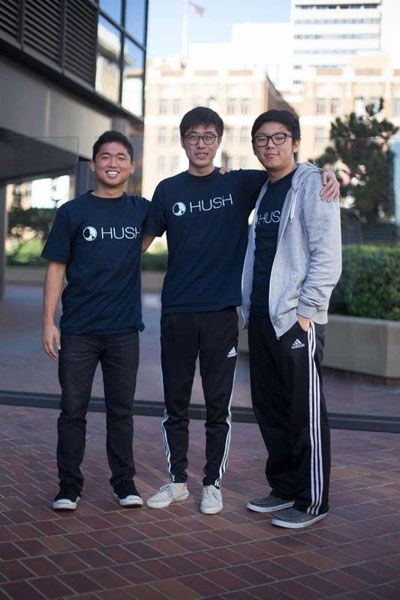
fellow co-founders of Hush
Last week it became known that a startup co-founded by Lee was acquired in August 2016 by the big audio company, Bose. Chesong Lee and mechanical engineering major Daniel Lee (no family relation) co-founded the company Hush to develop the first-ever 'smart' noise-cancelling earplug with white-noise options to help people block out noise while they sleep -- but still connect to their phone by allowing alarms and emergency notifications to reach the user. The technology developed at UC San Diego (originally conceived in a Jacobs School of Engineering course on Product Design and Entrepreneurship) was integrated into a new sleepbud product line at Bose, and the two Lees moved to Bose as part of the acquisition deal. (A third co-founder, Daniel Synn, opted not to join Bose.)
Even before the sale to Bose, Hush had proved to be a winning technology concept. The company was accepted into several startup incubators, including San Diego's EvoNexus. Hush also launched a Kickstarter crowdfunding campaign to raise $100,000 -- but instead raised nearly $600,000 in a single month.

on Hush technology are expected on the market
in 2018.
Daniel Lee and Chesong Lee brought their interest in crowdfunding to Bose, and launched a campaign on Indiegogo to raise $50,000 for initial buyers who would become testers of the prototype of Bose's noise-masking 'sleepbuds' based on the Hush technology. Before they sold out, Bose raised $450,000 from nearly 3,000 backers on Indiegogo -- nearly ten times more than they were seeking.
The formal consumer launch of the Bose sleepbuds is scheduled for sometime in 2018. Meanwhile, former CSE student Chesong Lee has returned to creating software apps -- which had already earned him millions of dollars even before the buyout of Hush.
UPCOMING EVENTS
Floorplan Representation, Global Placement and Routability Analysis for VLSI Layout Design Automation
This week two Ph.D. candidates will finish out the calendar year by mounting their final defenses of their doctoral dissertations. (See story below for Zachary Lipton's dissertation on Wednesday.) Today, Ilgweon Kang will present his dissertation as he nears completion of his Ph.D. in Computer Science (Computer Engineering), with a thesis on "Floorplan Representation, Global Placement and Routability Analysis for VLSI Layout Design Automation." Kang worked in the VLSI CAD Laboratory under his advisor, CSE Prof. C.K. Cheng, who will chair his faculty panel. The committee includes CSE professors Ronald Graham and Andrew Kahng, as well as ECE professors Bill Lin and Farinaz Koushanfar. As always, the examination is open to the public.
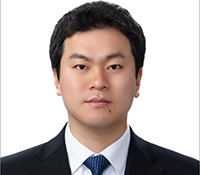
Ilgweon Kang
Date: Tuesday, December 12, 2017
Time: 10:00am
Location: Room 3109, CSE Building
In the face of Moore's Law and Dennard Scaling, Kang aruges that "designing integrated circuits (ICs) has become much more sophisticated and complicated... [and] IC layout design directly impacts timing closure, die utilization, routability, and design turnaround time (TAT); these in turn affect the classic design metrics of operating frequency, yield, power consumption and cost," he notes in the abstract of his dissertation. "As a result, physical design engineers face many nontrivial challenges, and the design cost increases rapidly. [Manufacturers] look for higher efficiency on design optimization, automation and innovation for better performance and cost reduction."
Kang's dissertation describes new design methodologies for improved IC layout development and design automation. He introduces new three-dimensional (3D) floorplan representations, which enhance 3D IC physical design automation. The floorplan representations are potentially extendable toward multiple dimensions by adding factors such as time, energy, temperature, security, etc. Among other contributions, Kang's dissertation describes "constraint-driven and routability-driven global placement engine, RePlAce, which is a flat, nonlinear analytical global placement engine with electrostatics-based global-smooth density cost function. He notes that RePlAce addresses routing congestion as well as classical design goals. The dissertation also presents a new framework that "quickly identifies the design rule-correct routability through well-organized Boolean satisfiability (SAT) formulation," notes Kang, adding that his "routability analysis method is developed upon the foundation of multi-commodity flow theory and SAT-friendly, integer linear programming (ILP)-based detailed routing formulation.
After graduation, Kang expects to continue working for Cadence Design Systems as a Lead Software Engineer. He joined the company full-time last January, after doing an internship with Cadence in San Jose in summer 2016.
'Mad Scientist' to Join Carnegie Mellon Faculty in January After Staging Final Dissertation Defense
The final final defense of calendar 2017 in the CSE department will take place on Wednesday, December 13, when Computer Science Ph.D. Candidate Zachary Lipton (M.S. '15) is set to defend his doctoral dissertation. His topic in the area machine learning and artificial intelligence: "Learning from Temporally-Structured Human Activities Data." His faculty committee is co-chaired by his advisors, CSE professors Julian McAuley and Charles Elkan, and the committee includes CSE professors Vineet Bafna and Gary Cottrell, as well as Cognitive Science professor Zhuowen Tu.
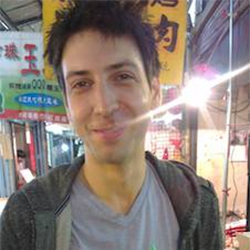
Zachary Lipton
Date: Wednesday, December 13, 2017
Time: 1:00pm
Location: Room 4140, CSE Building
Unlike most Ph.D. candidates, Lipton is not defending his dissertation prior to landing a job. As of January 2018, he becomes an Assistant Professor at Carnegie Mellon University, having been offered the position in the spring. Lipton's research spans theoretical and applied machine learning, with particular interest in deep learning with recurrent neural networks (RNNs), large-scale multi-label classification, natural language processing, and applications to medicine -- and music. (The computer scientist is also a former professional jazz musician who is a composer as well as a saxophonist and bassist.) Lipton will be making the final move to CMU near Pittsburgh from Palo Alto, where he has been working with Amazon Web Services since last January. He previously did summer internships at Microsoft in Redmond, WA, in 2016, Amazon in 2015, and Microsoft Research Labs in Bangalore, India, in 2014. (His current job at Amazon: "Mad Scientist at Amazon AI", according to Lipton's LinkedIn profile.) Prior to enrolling in CSE in 2013, Lipton earned a B.A. in Mathematics and Economics from Columbia University.
According to the abstract for his Ph.D. dissertation, Lipton noted that "despite the extraordinary success of deep learning on diverse problems, these triumphs are too often confined to large, clean datasets and well-defined objectives." As examples, he points to face recognition systems, which train on millions of perfectly annotated images, and commercial speech-recognition systems that train on thousands of hours of painstakingly-annotated data. "But for applications addressing human activity, data can be noisy, expensive to collect, and plagued by missing values," explains Lipton. "In electronic health records, for example, each attribute might be observed on a different time scale. Complicating matters further, deciding precisely what objective warrants optimization requires critical consideration of both algorithms and the application domain. Moreover, deploying human-interacting systems requires careful consideration of societal demands such as safety, interpretability, and fairness."
"The aim of this thesis is to address the obstacles to learning temporal patterns in human activity data," adds Lipton. Delineating his primary contributions to this field, he points to the first application of RNNs to multivariate clinical time-series data, with several techniques for bridging long-term dependencies and modeling missing data. Lipton also contributes a neural network algorithm for forecasting surgery duration while simultaneously modeling heteroscedasticity. Additional contributions contained in the dissertation include: "an approach to quantitative investing that uses RNNs to forecast company fundamentals; an exploration strategy for deep reinforcement learners that significantly speeds up dialogue policy learning; an algorithm to minimize the number of catastrophic mistakes made by a reinforcement learner; and critical works addressing model interpretability and fairness in algorithmic decision-making."
Lipton is planning to file his graduation paperwork this week following his dissertation defense on Wednesday, so his degree will be awarded in Fall 2017. He will be part of the 2017-2018 graduating class, eligible to participate in the 2018 Commencement.
ALUMNI SURVEY
Take the CSE Alumni Survey. It only takes a few minutes. We'd really like to hear from you!
|
GIVING OPPORTUNITIES |

